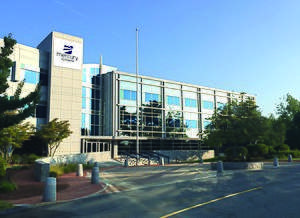Mercury Systems
 | |
 Front entrance of Mercury Systems' headquarters in Andover, MA | |
| Public | |
| Traded as | |
| Industry | Aerospace and defense |
| Founded | 1981 |
| Headquarters |
Andover, Massachusetts, United States |
Key people |
Mark Aslett[1] (President/CEO) |
| Revenue | $493 million USD (FY 2018)[2] |
Number of employees | ~1,300 (June 2018)[3] |
| Website |
www |
Mercury Systems, Inc.( NASDAQ: MRCY ) is a high-tech commercial company serving the aerospace and defense industries. Headquartered in Andover, Massachusetts. Mercury's products and solutions have been deployed in more than 300 programs with over 25 different defense prime contractors. Their processing subsystems are used in a wide variety of defense and commercial applications including command, control, communications, computers,iIntelligence, surveillance and reconnaissance (C4ISR), radar, electronic warfare (EW) and signals intelligence (SIGINT), sonar, missiles and munitions, and mission computing.[4]
Mercury is based in Andover, Massachusetts, with more than 1000 employees in offices around the world and annual revenues of approximately US$493 million for its fiscal year ended June 30, 2018.[5]
History
- Founded on July 14, 1981 as Mercury Computer Systems by Jay Bertelli.
- Went public on the Nasdaq stock exchange on January 30, 1998, listed under the symbol MRCY.
- In July 2005, Mercury Computer Systems acquired Echotek Corporation for approximately US$49 million.[6]
- In January 2011, Mercury Computer Systems acquired LNX Corporation.[7]
- In December, 2011, Mercury Computer Systems acquired KOR Electronics for US$70 million,
- In August 2012, Mercury Computer Systems acquired Micronetics for US$74.9 million.[8]
- In November 2012, the company changed its name from Mercury Computer Systems to Mercury Systems.[9]
- In December 2015, Mercury Systems acquired Lewis Innovative Technologies, Inc. (LIT). LIT’s security solutions significantly extend Mercury's leadership in secure embedded computing.[10]
- In May 2016, Mercury Systems acquired the embedded security, RF and microwave, and custom microelectronics businesses of Microsemi Corporation for a total purchase price of US$300 million.
- In November 2016, Mercury Systems acquired CES Creative Electronic Systems, S.A. (“CES”) for approximately US$38 million. The addition of CES adds capabilities in mission computing, safety-critical avionics and platform management.[11]
- In April 2017, Mercury Systems acquired Delta Microwave, LLC (“Delta”) for US$40.5 million, enabling the Company to expand into the satellite communications (SatCom), datalinks and space launch markets.[12]
- In July 2017, Mercury Systems acquired Richland Technologies, LLC (RTL), increasing the Company's market penetration in commercial aerospace, defense platform management, C4I, and mission computing.[13]
- In February 2018, Mercury Systems acquired Themis Computer for US$180 million, broadening the Company's capabilities in rugged servers and tactical cloud computing solutions.
- In July 2018, Mercury Systems acquired Germane Systems, LC for US$45 million, which, combined with the Company's acquisition of Themis Computer, further extends its presence in rugged servers and storage devices for aerospace and defense applications.
Products and Services
Mercury's Next Generation Business Model
To meet Department of Defense (DOD) defense electronics procurement reform objectives, Mercury created a Next Generation Business Model.[14] Defense procurement reform objectives are captured by the Department’s Better Buying Power 3.0 (BBP3.0)[15] under the overarching theme of “Achieving Dominant Capabilities through Technical Excellence and Innovation.”
Open System Architecture (OSA) for Digital and RF/Microwave Processing
Mercury has a systematic approach to the creation of defense processing subsystems using a sensor processing chain methodology to define reusable building blocks.[16] This business approach leverages best commercial technology making Mercury processing building blocks interoperable and standardized, so defense processing subsystems are quickly developed.

Open system architectures (OSA) are fundamental to meeting the DOD’s BBP 3.0 objectives and are aligned with Mercury’s business posture.[17] The company pioneered many of today’s embedded protocols and processing standards including RapidIO and OpenVPX (ANSI/VITA 65 standard) which is the de facto embedded digital processing standard.
Currently, the company is investing in OpenRFM for Radio Frequency (RF) and microwave processing that will bring interoperability to the RF/microwave domain, as OpenVPX did in the digital realm. OpenRFM standardizes the profiles, interfaces and protocols for RF and microwave processing enabling sensor chain applications to be fully open systems compliant.[18] Mercury applies open systems architectures to software as well as hardware. This approach, applied to middleware preserves the software and application investments while adding new capabilities through tech-refreshes.
Facilities
Corporate Headquarters
Mercury is headquartered in Andover, Massachusetts.[19] The facility incorporates a design and engineering capability and an "Innovation Center". Mercury Innovation Centers showcase the company’s sensor and mission processing solutions.[20]
Manufacturing Centers
Mercury has redundant, scalable Advanced Microelectronic Centers (AMCs). AMCs are for the production of defense industry subsystems. AMCs are operated in New England, New York Metro-area, Southern California and a trusted DMEA facility in the Southwest.[19]
Company structure
Mercury has three major product lines:
• Advanced Microelectronic Solutions / RF & Digital Solutions
• Sensor and Mission Processing - Mercury Mission Systems; Safety-critical avionics, mission processing, networking, and communication; Secure high-performance sensor processing, storage, and networking
• Mercury Defense Systems – Electronic Warfare; Secure Processing Solutions; Test & Simulation
Mercury’s businesses are supported by several dedicated international operations including: Toronto, Canada, Silchester, United Kingdom, Tokyo, Japan and Geneva, Switzerland. [21]
References
- ↑ https://www.mrcy.com/company-information/management-team/
- ↑ https://www.mrcy.com/presscenter/pressreleases/pressrelease.aspx?id=16784
- ↑ https://www.mrcy.com/company-information/company-facts/
- ↑ https://www.reuters.com/finance/stocks/companyProfile?rpc=66&symbol=MRCY.O
- ↑ https://www.mrcy.com/presscenter/pressreleases/pressrelease.aspx?id=1924
- ↑ https://www.mrcy.com/presscenter/pressreleases/pressrelease.aspx?id=14795
- ↑ "Military and Aerospace Electronics". Retrieved 15 November 2012.
- ↑ Mercury Systems (November 13, 2012) Mercury Computer Systems Announces Name Change to "Mercury Systems" press release.
- ↑ https://globenewswire.com/news-release/2015/12/16/796160/0/en/Mercury-Systems-Acquires-Lewis-Innovative-Technologies-Inc.html
- ↑ https://globenewswire.com/news-release/2016/11/03/886366/0/en/Mercury-Systems-to-Acquire-Mission-Computing-Company-Creative-Electronic-Systems.html
- ↑ https://www.mrcy.com/presscenter/pressreleases/pressrelease.aspx?id=16699
- ↑ http://mil-embedded.com/news/mercury-systems-acquires-richland-technologies/
- ↑ https://www.mrcy.com/resources/Driving-a-Next-Generation-Business-Model-in-Defense-Electronics-White-Paper.pdf
- ↑ http://www.acq.osd.mil/fo/docs/betterBuyingPower3.0(9Apr15).pdf
- ↑ https://www.mrcy.com/commercial_electronics/
- ↑ http://archive.cotsjournalonline.com/articles/view/101447
- ↑ https://www.mrcy.com/OpenRFM/
- 1 2 http://www.dmea.osd.mil/home.html
- ↑ https://www.mrcy.com/presscenter/pressreleases/pressrelease.aspx?id=16331
- ↑ http://www.mrcy.com
External links
- Business data for Mercury Systems: Google Finance
- Yahoo! Finance
- Reuters
- SEC filings